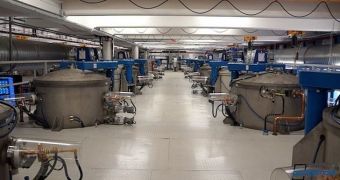Analyst Matt Margolis is known to have ties to Apple’s sapphire business in Mesa, Arizona, where the contracted GT Advanced is cooking up copious amounts of the exotic material for upcoming devices.
Few people know exactly what the massive sapphire plant in Arizona is for, but most company watchers agree it’s for the iPhone 6 and the iWatch. Margolis is equally convinced of that, and he has new data to back up his claims.
In a post left over at Seeking Alpha, Margolis points out that Apple has so much sapphire on its hands right now it would be impossible to use it for a single product line. As such, he estimates that the ultra-hard crystal will be used in as many as three different devices, two of which are differently-sized iPhones.
After taking into account some math done by UBS, whose Stephen Chin has been one of the most vocal analysts covering GTAT, Margolis writes, “I believe that the Mesa sapphire operations will have ample supply to cover the iWatch, the 4.7" iPhone and the 5.5" iPhone with full sapphire cover glass in 2014.”
“Additionally, the maximum sapphire screen capacity of the Mesa facility is likely to exceed 200m annual units. My most recent supply chain check confirms that GT's sapphire business with Apple is likely to approach or exceed $2B [€1.47B] annually or $2.00 [€1.5] earnings per share using an estimated ASP of $10 [€7.4] per unit.”
Margolis’ latest supply chain checks have indicated that GT has installed a whopping 2,500 furnaces churning out sapphire boules between 200 kg (440 pounds) and 235 kg (518 pounds) each.
With production having started in February of this year, Apple has – without any doubt – enough of this material even to sell some to competitors like Samsung.
Harder and less prone to scratches than normal glass, sapphire crystal isn’t a novelty but it will be for the iPhone. Apple currently employs Corning’s well-known Gorilla Glass which, at its third iteration, is not only highly scratch-proof but also bendable.
Apple uses the second-generation Gorilla Glass and seems unimpressed by the performance of the third-gen glass from Corning. Hence they’ve enrolled the services of GT Advanced to make sapphire in-house. Not surprisingly, Corning has expressed concern about “some smartphone vendors’” decision to replace Gorilla Glass with sapphire, indirectly referring to Apple.
Corning has been proved wrong on several occasions regarding its arguments pitting Gorilla Glass against sapphire, and it will likely lose Apple as a partner starting this year.
iPhone 6 is expected to arrive sometime in September, and the iWatch will follow in its footsteps in the same fall timeframe, according to company watchers.

 14 DAY TRIAL //
14 DAY TRIAL //